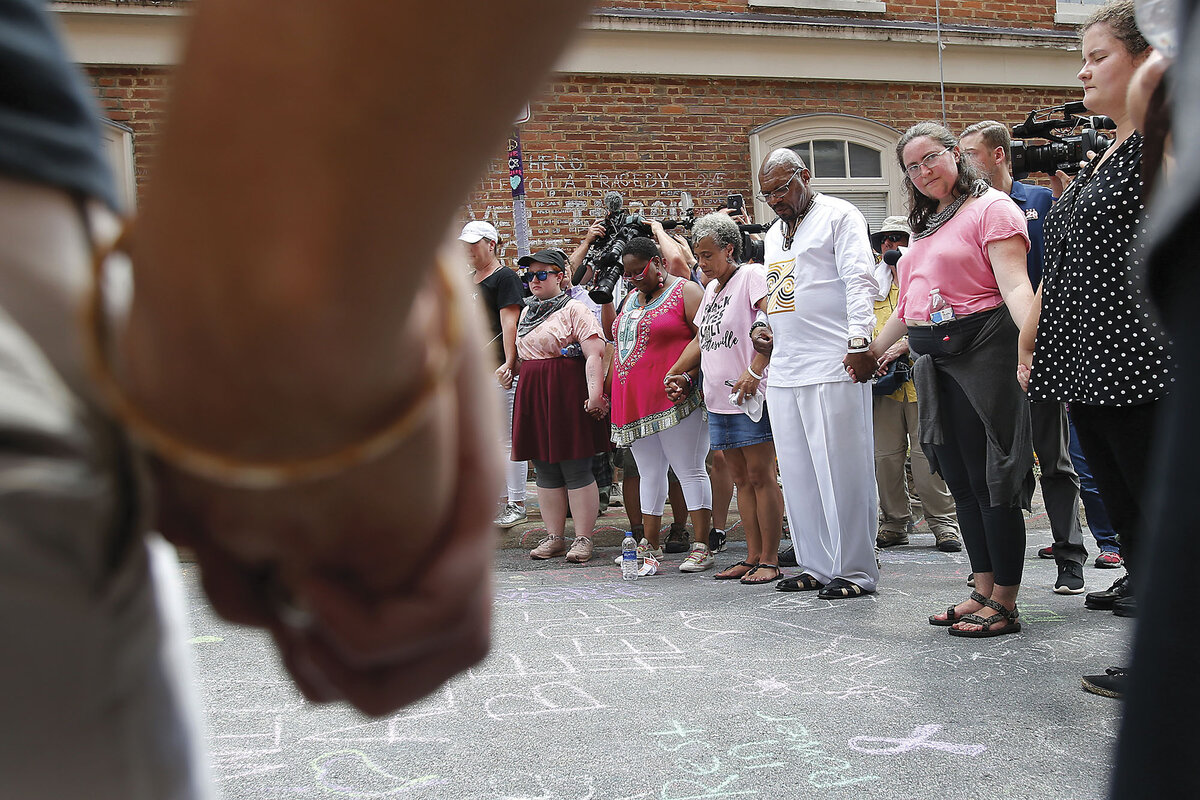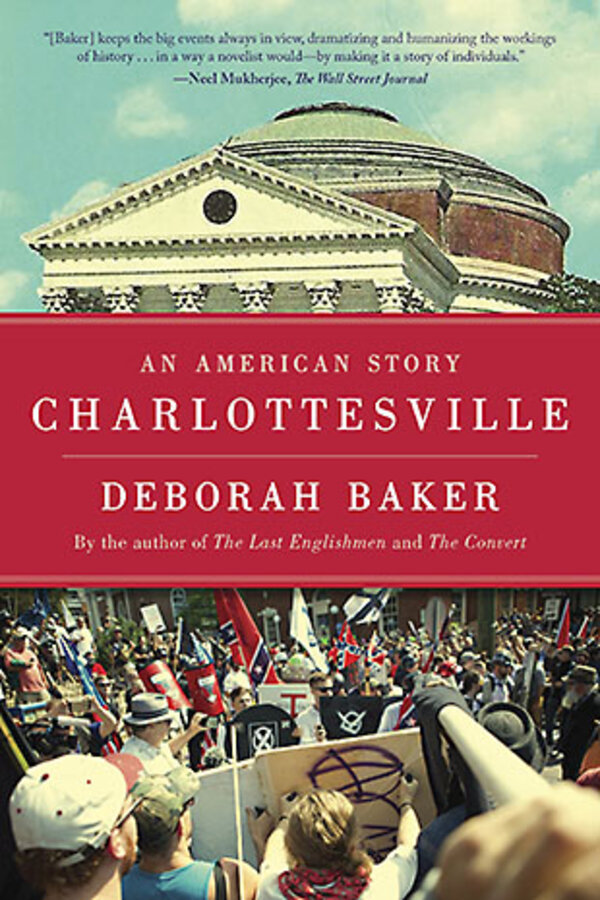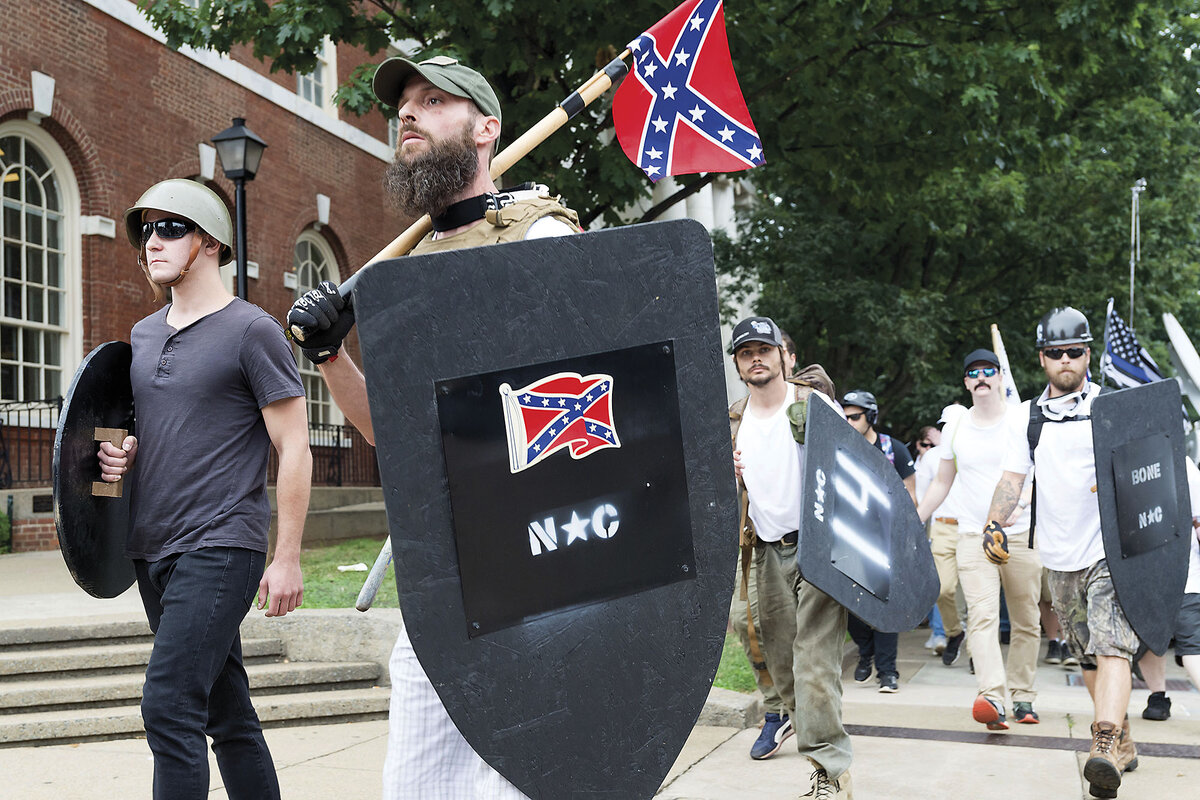The day that Unite the Right marched in Charlottesville
Loading...
After the Aug. 12, 2017, Unite the Right rally in Charlottesville, Virginia, President Donald Trump famously said there were ŌĆ£very fine people on both sides.ŌĆØ Deborah BakerŌĆÖs ŌĆ£Charlottesville: An American StoryŌĆØ is, among other things, an exhaustive rebuttal to the presidentŌĆÖs statement. The compelling book presents a blow-by-blow account of the white supremacist rally and the torch-filled march that preceded it. Baker also provides historical context for that summerŌĆÖs unrest and spotlights the local clergy and activists who led the small Southern cityŌĆÖs robust counterprotests.┬Ā
The rally was organized in response to a controversial vote by the Charlottesville City Council to remove a statue of Confederate Gen. Robert E. Lee from a downtown park. Charlottesville was not alone in reconsidering its monuments to the Confederacy: In the wake of the 2015 racist murder of nine congregants at a Black church in Charleston, South Carolina, other Southern states and localities had withdrawn Confederate memorials and flags from public spaces. ┬Ā
While Baker ably describes the coalition of white nationalists, neo-Nazis, Klanspeople, and armed militia members who descended on Charlottesville ŌĆō more than 1,000, according to the Virginia Department of Emergency Management ŌĆō she is more focused on the city residents who mounted a coordinated response. Many of them had been collaborating on social justice issues long before the weekend of the rally; in advance of the August events, they studied principles of nonviolent resistance.┬Ā
Why We Wrote This
Racism and hatred are not easy to uproot. Books that examine not only how bigotry operates, but also the efforts to eradicate it, provide a wakeup call ŌĆō and an appeal for vigilance.
The author writes about the Charlottesville Clergy Collective, a multiracial group formed by the Rev. Alvin Edwards of Mount Zion First African Baptist Church after the Charleston massacre, and the local chapter of Showing Up for Racial Justice, which featured a younger cohort of activists. ŌĆ£Friendships were made and alliances were forged across race, faith, ideological, and generational divides,ŌĆØ Baker observes, noting that these groups ŌĆ£formed the holy core of the cityŌĆÖs response to what would soon become known as the Summer of Hate.ŌĆØ┬Ā
Baker, who says she interviewed around 100 people in researching the book, describes the events through the eyes of these local activists: the Aug. 11 nighttime torch march on the grounds of the University of Virginia, during which demonstrators chanted ŌĆ£Jews will not replace usŌĆØ; the violence that erupted during the chaotic rally the next day, culminating in the murder of counterprotester Heather Heyer in a car attack that also injured many others. The co-founder of the SURJ chapter tells Baker that she gained strength to face the rallygoers on the streets by recalling a touchstone of the Civil Rights Movement: ŌĆ£Would she have braved the walk over the Edmund Pettus Bridge?ŌĆØ
A powerful symbol ┬Ā
The monument to General Lee was unveiled in 1924, a time when the Ku Klux Klan was resurgent nationwide, and like other Confederate monuments of the period, part of its raison dŌĆÖ├¬tre was to promote white supremacy and intimidate the Black population. Baker, a native of the city, points out that Lee had never been to Charlottesville.┬Ā
During the statueŌĆÖs dedication, Lee was remembered as ŌĆ£that stainless leader of a stainless cause.ŌĆØ Shortly after the dedication, the author writes, ŌĆ£a spate of cross burnings around the county ended with the bombing of a Black church west of town. ... This was how CharlottesvilleŌĆÖs Black citizens were made to understand what the arrival of LeeŌĆÖs statue meant for them.ŌĆØ
The organizers of Unite the Right framed the removal of the monument as an attack on their heritage, but Baker argues that their agenda had more to do with the future than the past. Neo-Nazi Richard Spencer, one of the rallyŌĆÖs headliners, declared in a speech in late 2016 that ŌĆ£America was, until this past generation, a white country designed for ourselves and our posterity. It is our creation; it is our inheritance, and it belongs to us.ŌĆØ His words were met with a number of Nazi salutes from audience members.
Charlottesville unprepared┬Ā
As an independent investigation later concluded, the city was unprepared for the events of August 2017. Baker reports that the police briefings leading up to the weekend focused on the dangers of vaguely defined anti-fascist and anarchist extremists instead of on the Unite the Right rally-goers, who had clearly stated their intention to foment violence. (Rally organizer Jason Kessler had texted Spencer, ŌĆ£We are raising an army, my liege. For free speech, but the cracking of skulls if it comes to it.ŌĆØ)┬Ā
The author laments that in the wake of the rally, some media outlets fell prey to ŌĆ£bothsidesism,ŌĆØ searching for examples of violence by counterprotesters. She writes that ŌĆ£there was simply no comparisonŌĆØ between the violence of the far-right marchers and those who showed up to resist them.
The Lee statue was melted down in 2023, part of a plan to transform it into an inclusive work of public art. Violent political extremism will not be as easily destroyed. But Baker offers hope in the example of those who defended the city: ŌĆ£ordinary Americans standing up and fighting in myriad ways, for what is right.ŌĆØ┬Ā







